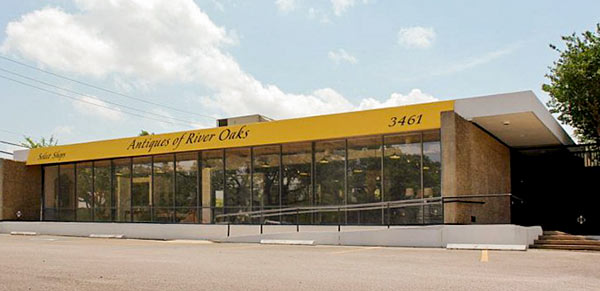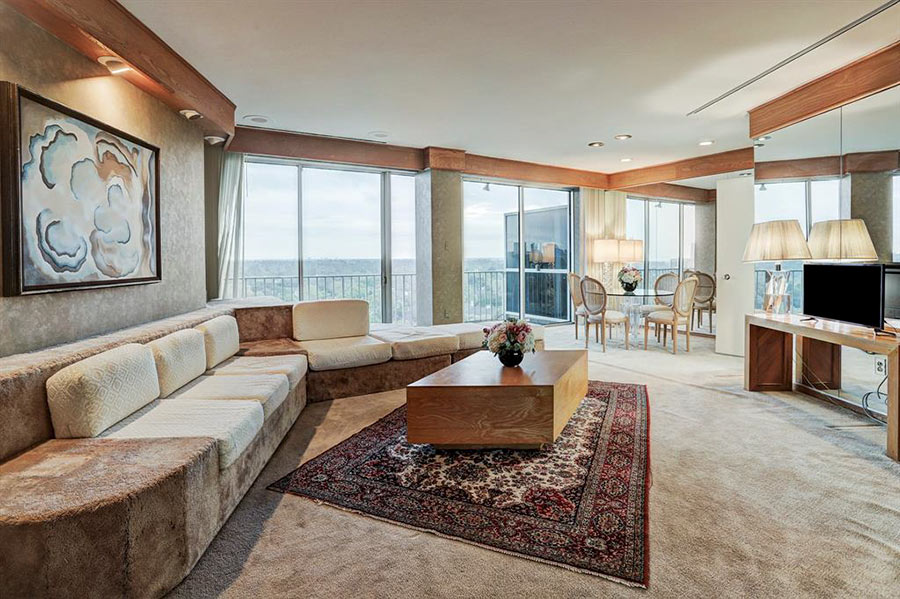THE UNDERAPPRECIATED RICHES OF HOUSTON’S ANTIQUE SET  “Someday,” antique dealer and appraiser David Lackey muses to intrepid radio reporter Allison Lee, “the Millennials . . . may be horrified when their children want mahogany furniture and doilies and figurines.” But for now, Lackey seems resigned to the great generational decline — and accompanying price drops — in the market for antique furniture: “There are half as many antique shows in Houston as there were 20 or 30 years ago,” he tells Lee. “Traditional English and American furniture, overall, has fallen maybe 50 to 75 percent.” Lackey operates his business out of the Antiques of River Oaks antiques megashop (pictured above) in the home-furnishings-themed shopping center at 3461 W. Alabama north of Greenway Plaza, but he’s also out and about, soaking up the zeitgeist: “I go into more estates — or I’m working with older people and they’re selling a lot of their stuff because they say their kids and grandkids do not want it. They’ve made it very clear. The younger generation, for the most part, is not very interested in formal candlelight suppers. They don’t want silver, china, crystal, because they don’t intend to entertain that way.†[Houston Public Media] Photo: David Lackey Antiques & Art
“Someday,” antique dealer and appraiser David Lackey muses to intrepid radio reporter Allison Lee, “the Millennials . . . may be horrified when their children want mahogany furniture and doilies and figurines.” But for now, Lackey seems resigned to the great generational decline — and accompanying price drops — in the market for antique furniture: “There are half as many antique shows in Houston as there were 20 or 30 years ago,” he tells Lee. “Traditional English and American furniture, overall, has fallen maybe 50 to 75 percent.” Lackey operates his business out of the Antiques of River Oaks antiques megashop (pictured above) in the home-furnishings-themed shopping center at 3461 W. Alabama north of Greenway Plaza, but he’s also out and about, soaking up the zeitgeist: “I go into more estates — or I’m working with older people and they’re selling a lot of their stuff because they say their kids and grandkids do not want it. They’ve made it very clear. The younger generation, for the most part, is not very interested in formal candlelight suppers. They don’t want silver, china, crystal, because they don’t intend to entertain that way.†[Houston Public Media] Photo: David Lackey Antiques & Art





I anxiously await the Hot New Trend of Hipster Candlelight Suppers, and will voraciously devour the flood of listicles and articles……”32 Ways To Make Your Candlelight Supper The Most Bestest Ever” , “Candlelight Suppers: You’re Doing it Wrong”, “Soy Candles: How to Make Your Candlelight Supper Super Eco-Friendly”, and “Here’s Why You Should Have Fire Extinguishers At Your Next Candlelight Supper”
I have a different name for Antiques, functionally obsolete garbage.
I’ve never understood walking into a run of the mill furniture store and plunking down 2k or 3k for a dining room set. There is so much high quality antique (or even not as old) furniture out there for half the cost and in a wide variety of styles. Plus it has the feel and workmanship you can’t find in new furniture these days. It is also usually smaller and more to scale for those living in smaller houses or tighter spaces.
My mom has an amazing collection of stuff like this. I think about it all the time….worried what I’m going to to with my great great grandfathers table, and my great grandmothers silver. I don’t have the room for it at this point in my life….but I don’t want to give it away. I almost feel like I need to get a storage unit for it.
Stop blaming millenials for everything. The decline in English and American antiques has much more to do with Pottery Barn. Restoration Hardware, Houzz, and pintrest than 20 somethings who drink PBR and have funny beards. The interior design industry has largely turned its back on antiques over the past 15-20 years and it has nothing to do with the tastes of millenials. The big buyers of home furnishings are homeowners with disposable income. They have all been lead away from traditional antiques by the design industry and now want the latest design fad instead of something more timeless. If anything, millenials have bucked the Pottery Barnaucracy by going for mid century pieces. That is where there is a pretty vibrant market.
Since when were young people EVER into antiques? Were baby boomers really going antique hunting in their 20s? Seems to me that the cause of the decrease in antique prices is the result of increase supply from a larger number of estate sales and internet auctions.
I totally identified with this, and this article is a more in-depth explanation of the change in generations.
http://www.nextavenue.org/nobody-wants-parents-stuff/
I agrees with Heightsresident. 20yrs ago just so happens to coincide with the rise of the internet and global trade. The internet fundamentally changed the game for all types of collectibles by increasing supply/access at a far greater clip than natural demand. Trade also made the price of furniture plummet. Not that the quality is comparable by any means, but you can buy cheaply made new furniture with clean lines and looks for next to nothing. Considering the age range of prime furniture buyers and their temporary lifestyles before moving on to aging in place with kids in the burbs, it’s understandable why they’re not interested in investing in antiques that require time & knowledge to source & appreciate in the first place. Just get something cheap with a low delivery cost and you’re all set for 10yrs before you have kids and it all becomes meaningless anyways.
It’s not just the circumstances of death (which have never changed) and changing aesthetic preferences (which have never changed in the sense that they keep on changing), the antique market is driven by demography.
.
Where do antiques come from? Well, most antiques that have survived to the present day were somewhat expensive to begin with and not every family could afford them. Families that were better-off tended not to have as many children or as early in life, and in the wake of the green revolution and post-war urbanization and as female workforce participation increased, fertility plummeted and there was less time to allocate toward household tasks of all sorts. So nowadays you have these historically-well-to-do families with fewer and fewer children and grandchildren or none at all, generations are spaced-out further both in age and in geographic distance, there’s less physical need for this stuff (or even simply an inability to accommodate it), *and* less appreciation for it.